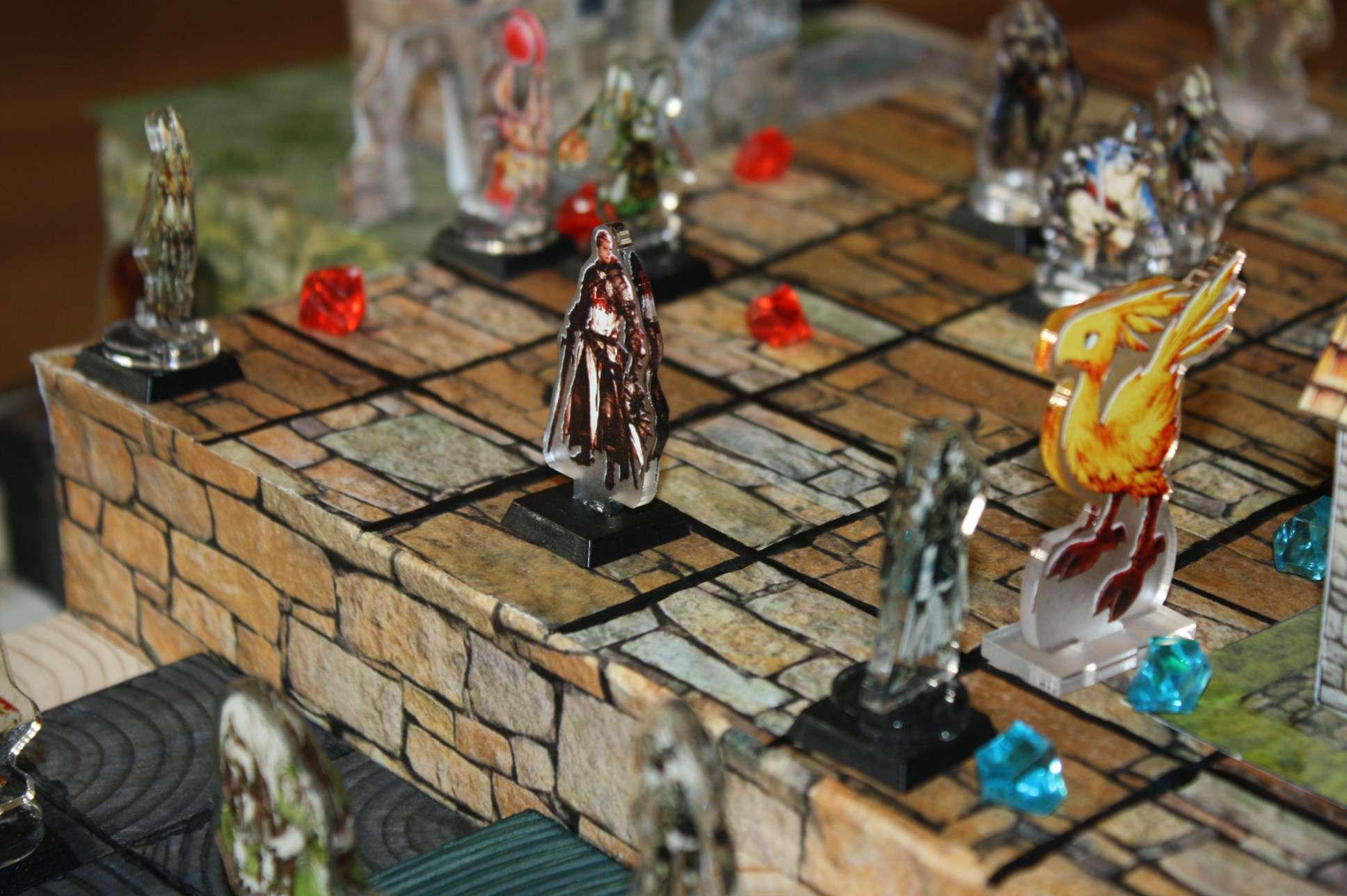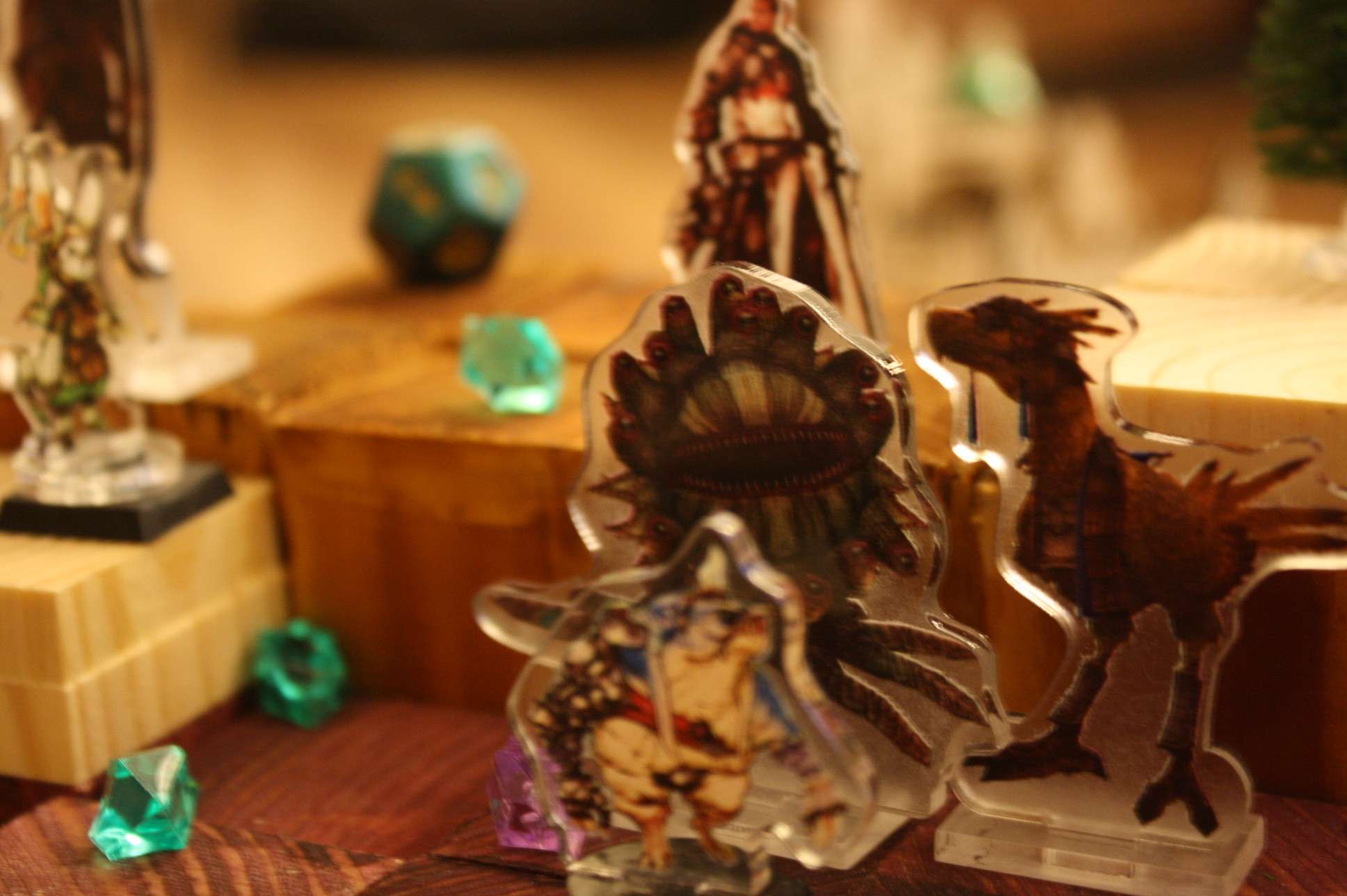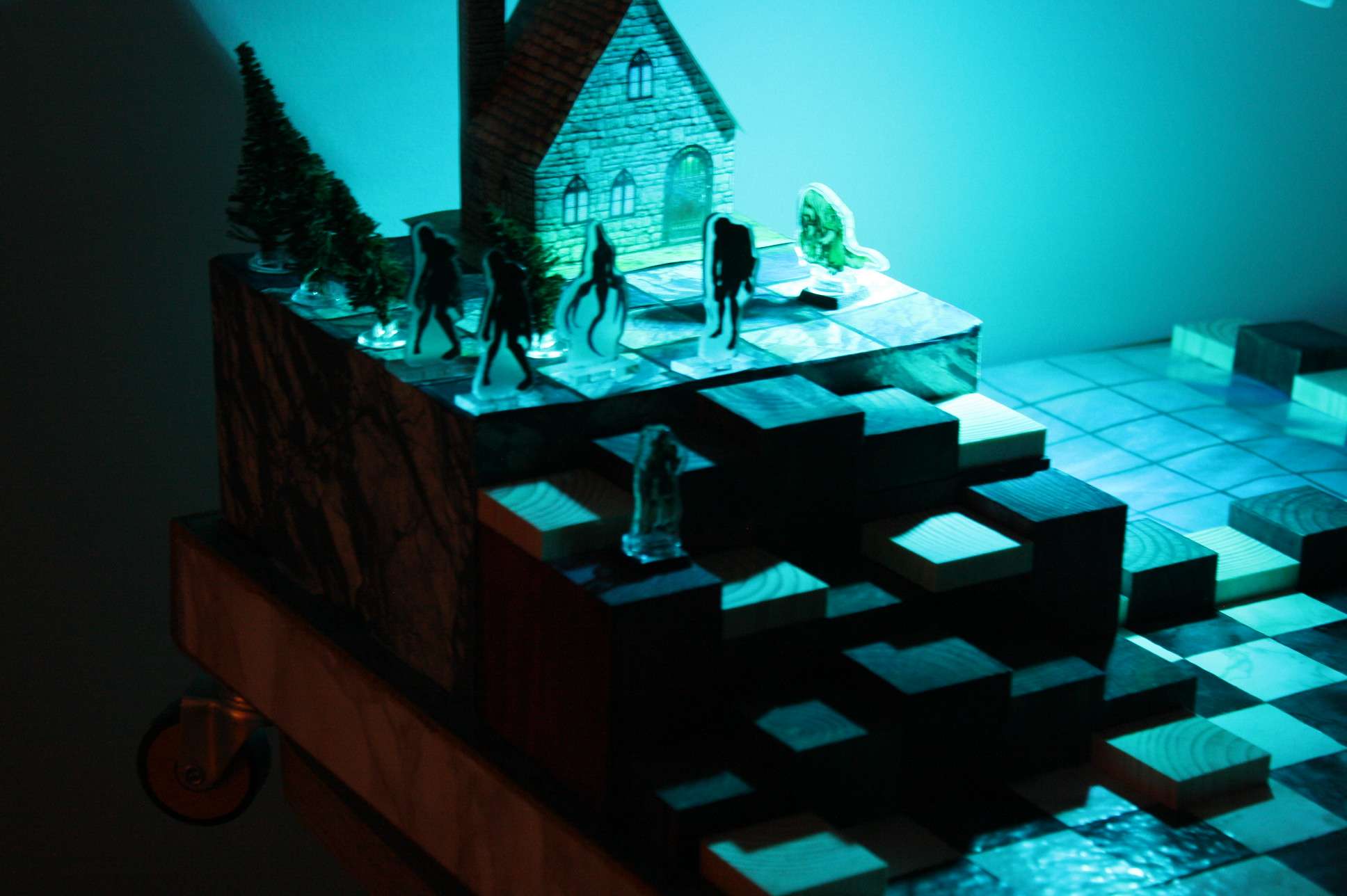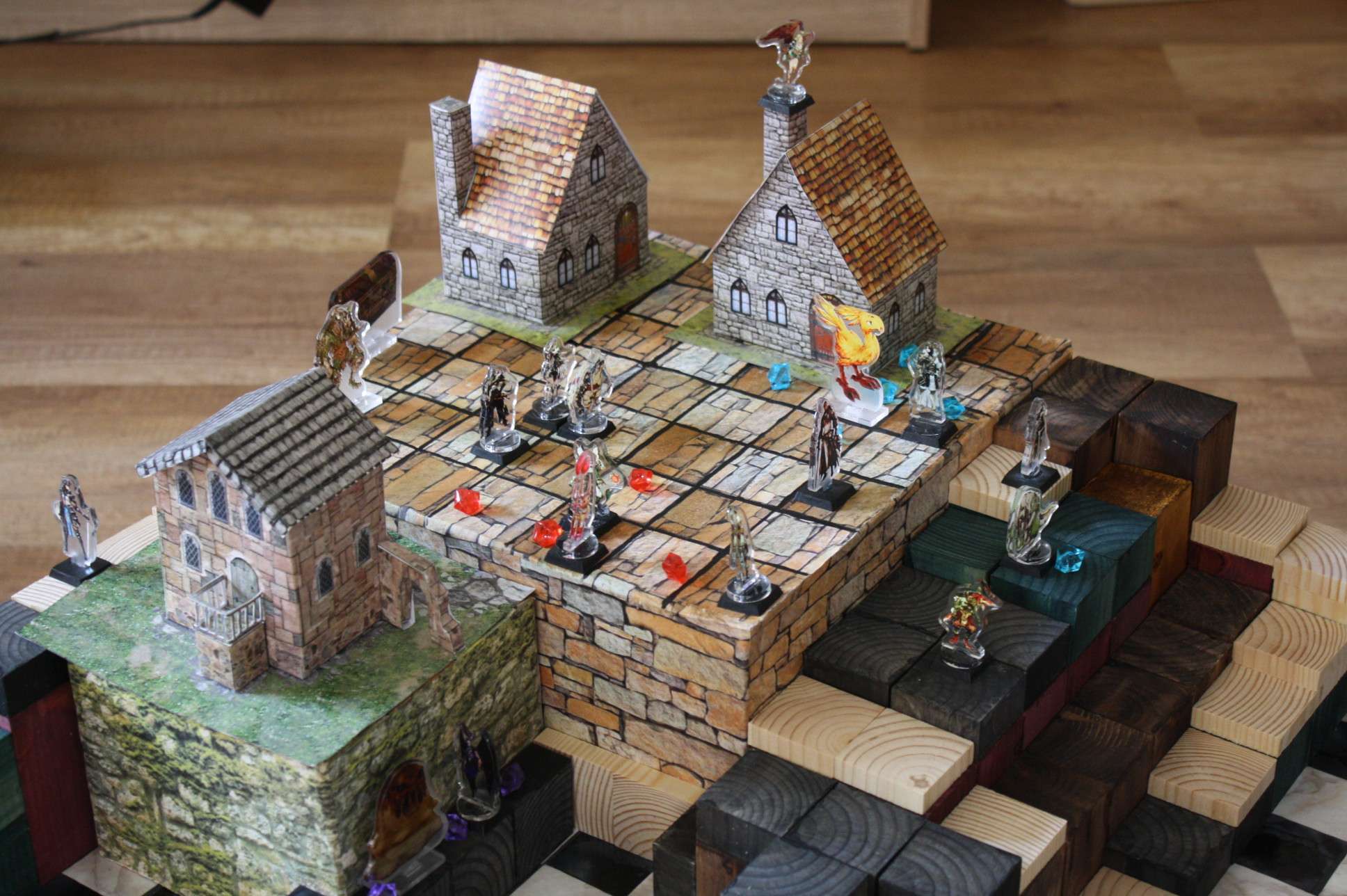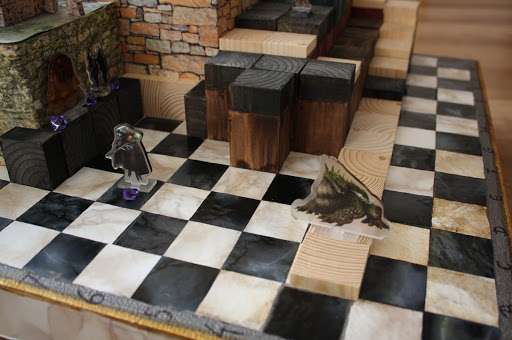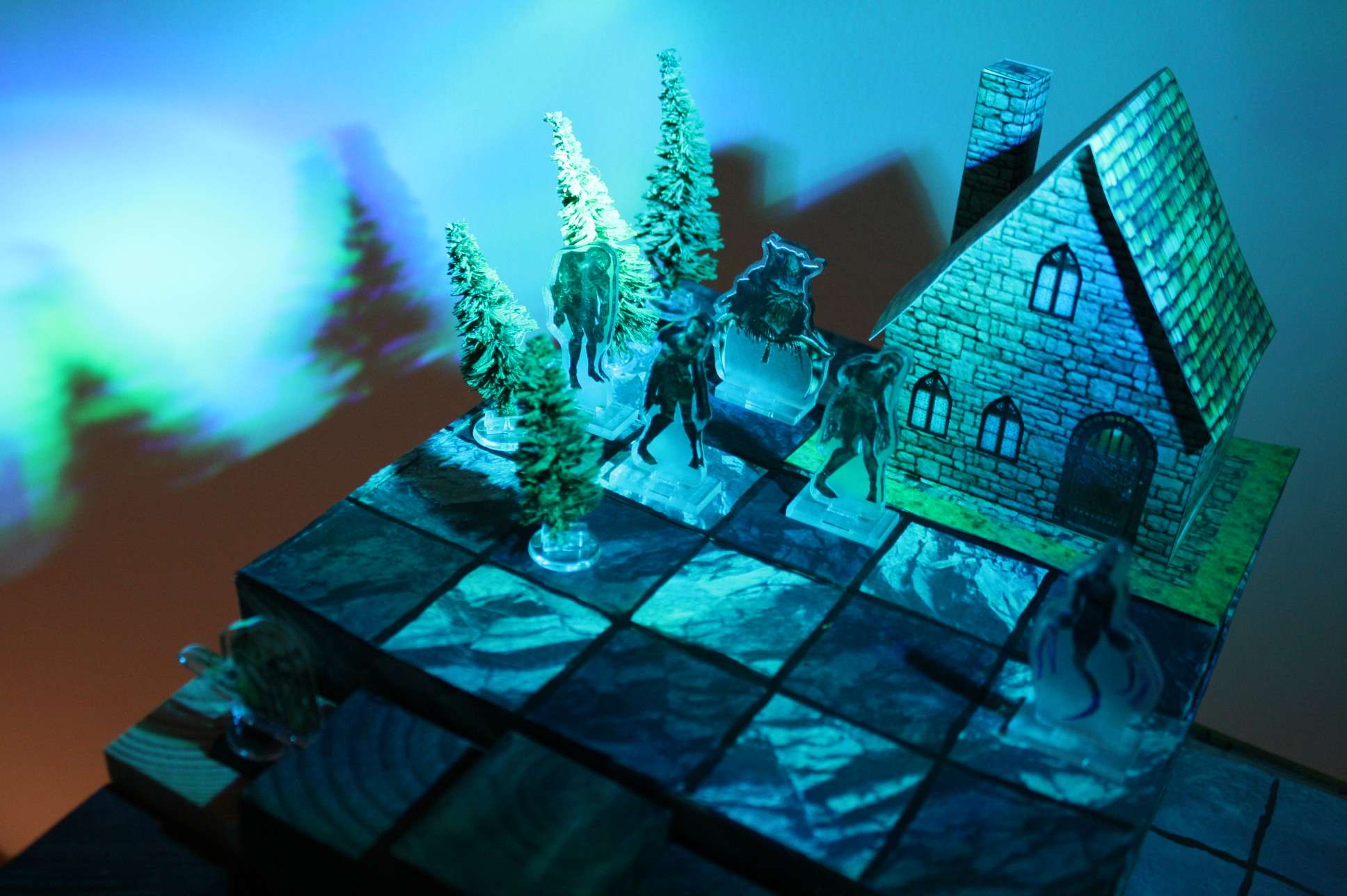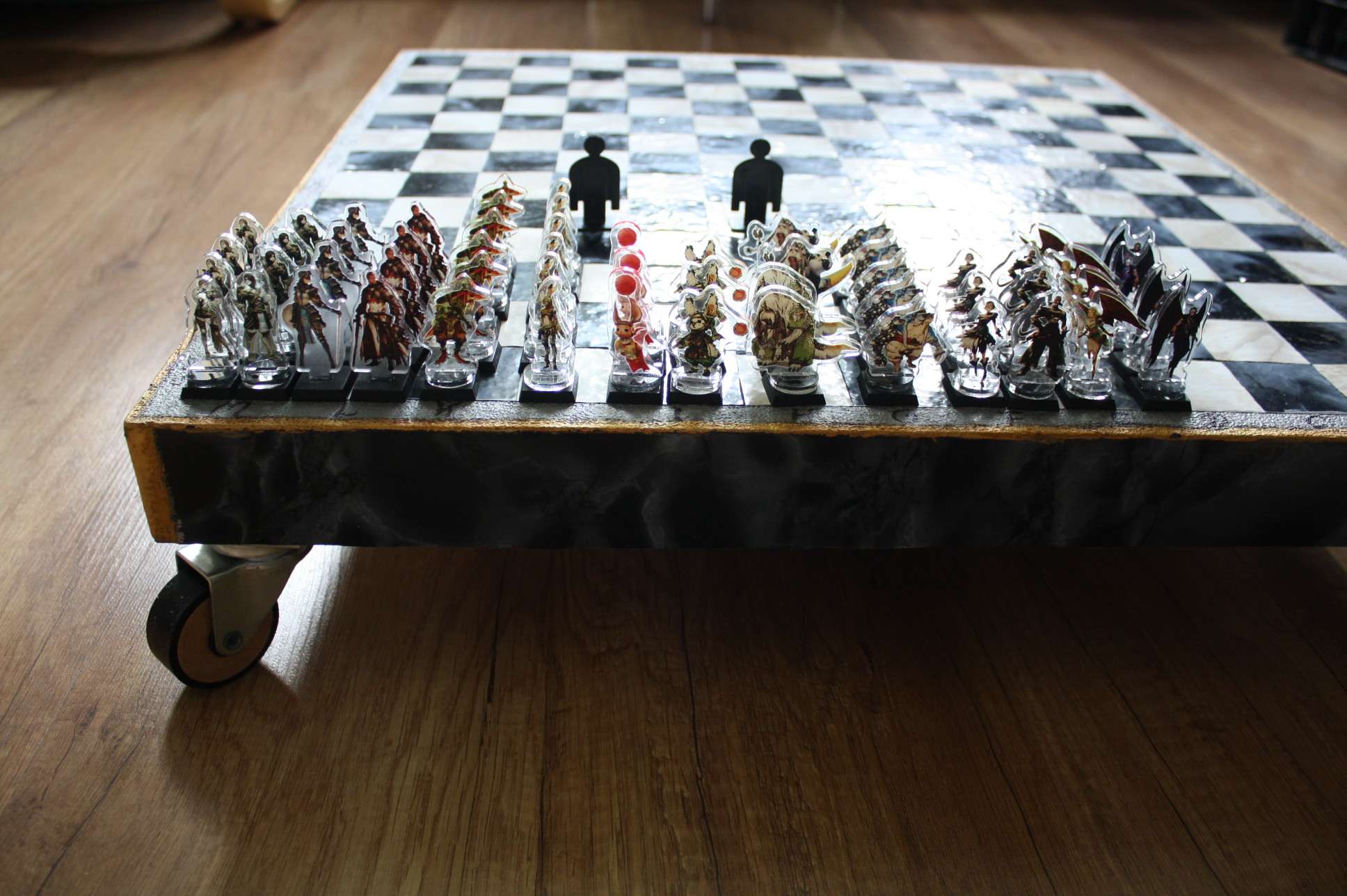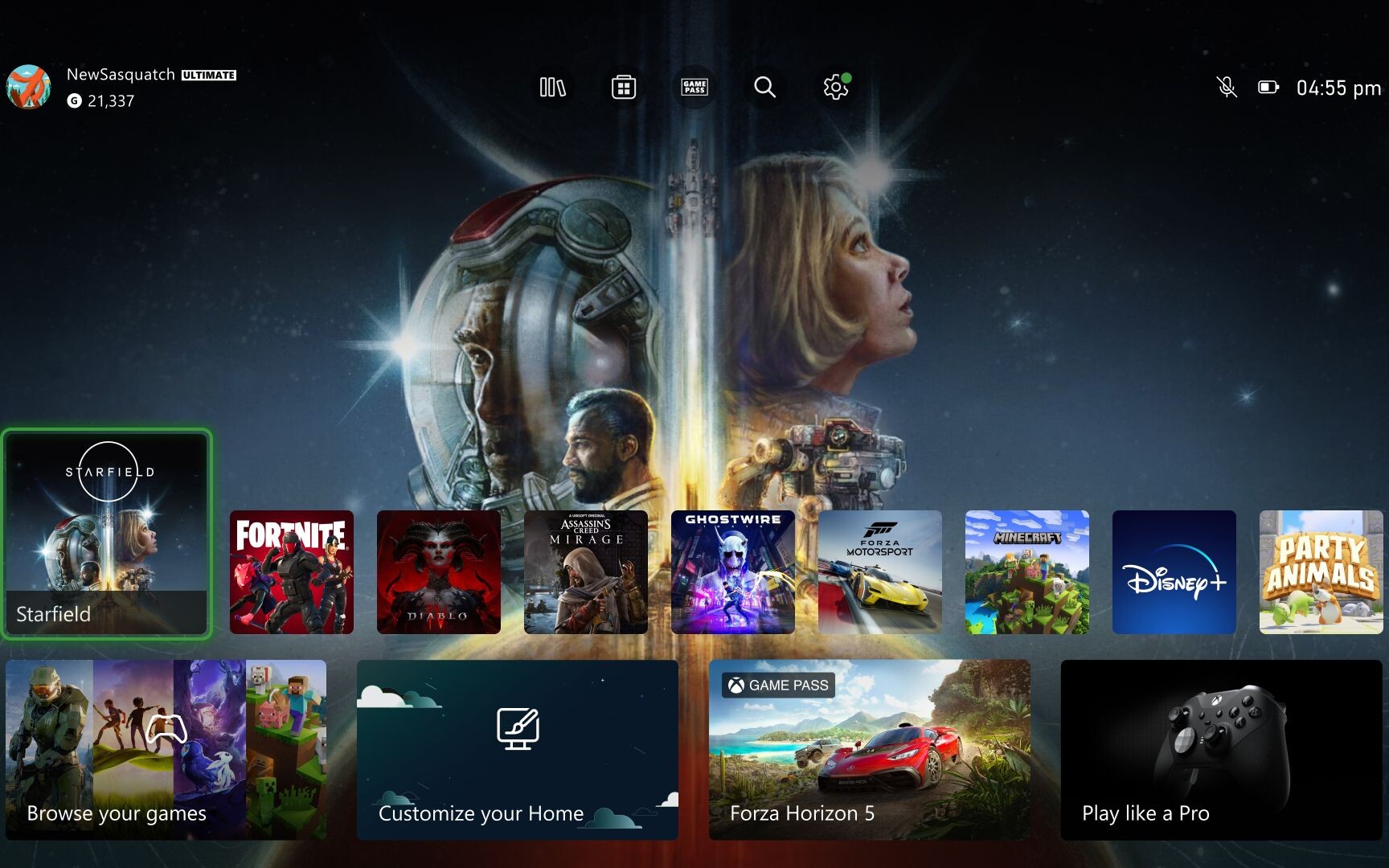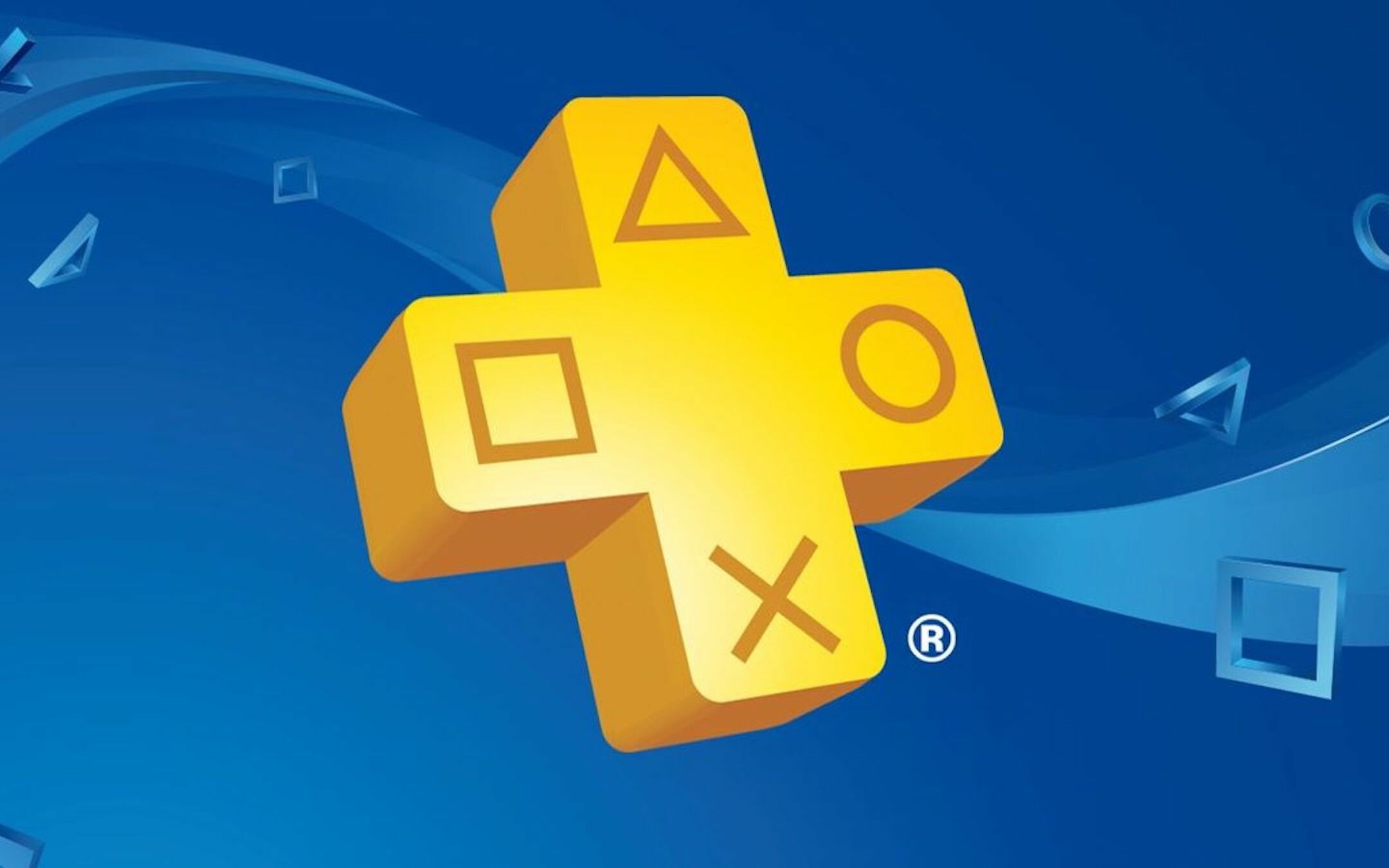Final Fantasy Tactics: Ivalice
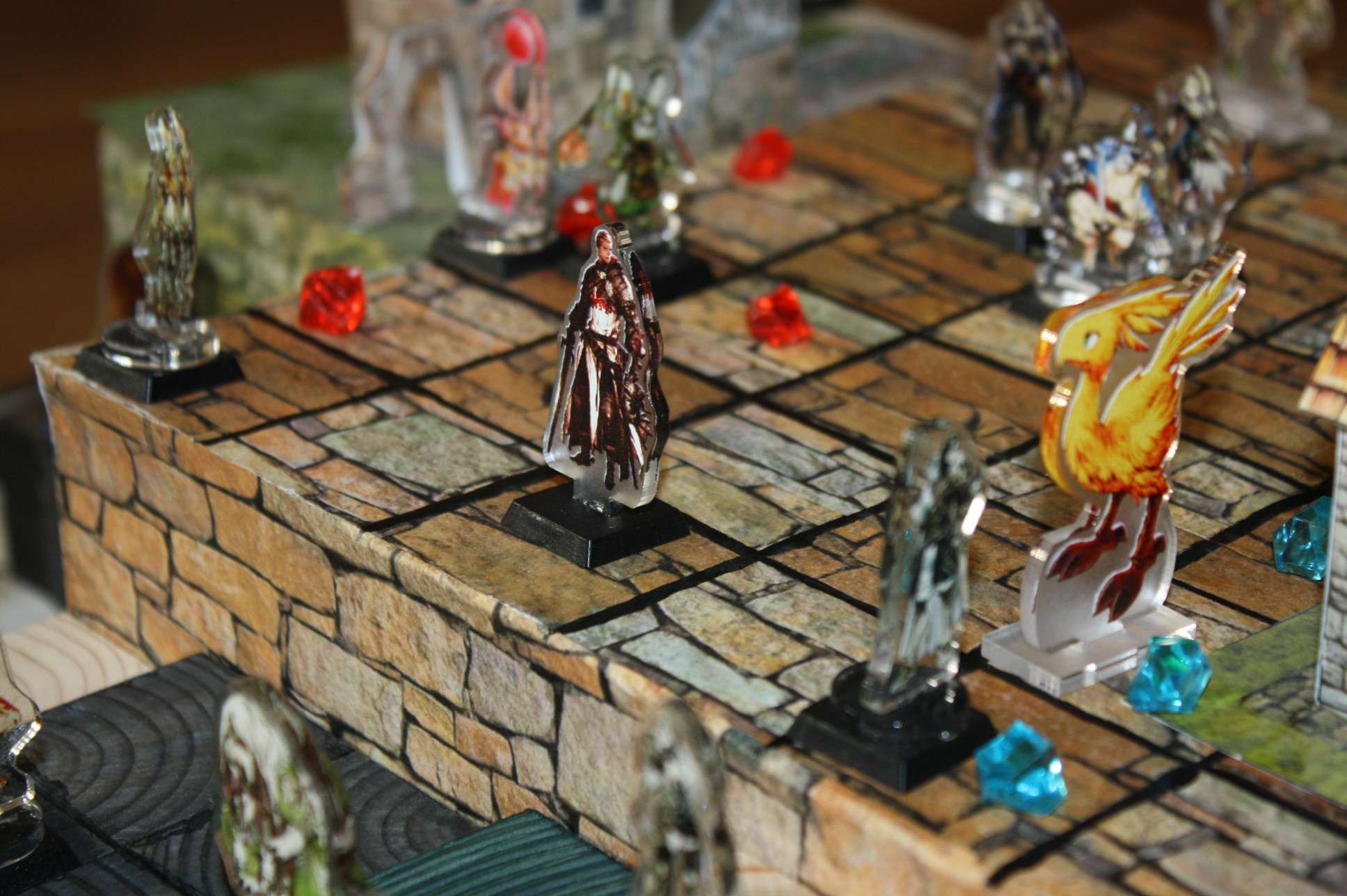
Mieliście kiedyś swój najbardziej kochany tytuł? Taką grę, którą wymienicie od razu odpowiadając na pytanie „W jaką jedną grę możesz grać do końca życia”? Ja należę do tych pechowców, którzy mają tylko jedno życie, a takich gier kilka, a zasadniczo cały cykl. To Ivalice, z Final Fantasy Tactics na czele. Cykl gier, który wyniosłem z cyfrowego świata i stworzyłem własną jego fizyczną reinkarnację. Ujrzyjcie! Taktyczną, fabularną grę planszową!
Zgadza się, taki ze mnie psychofan gry, wziął i zrobił dla siebie i swoich kumpli grę planszową. Z drewna, papieru, metalu i plastiku! Droga do tego, że mogę z przyjemnością się z Wami podzielić swoją pasją była kręta, długa, wyboista i dziurawa i dokładnie dowiecie się jak to było, a swą opowieść podzieliłem na parę części. Siądźcie zatem wygodnie poszukiwacze przygód i zawieście swój wzrok na hakach uwagi.
Część pierwsza, ale nie tak to się zaczęło.
Z grami cyklu Ivalice stykałem się w zupełnie innej kolejności niż wychodziły na rynek. Najpierw Vagrant Story, następnie Final Fantasy Tactics, FFT Advance i Final Fantasy XII. Są decyzje w życiu człowieka, które wyrokują o naszym obecnym położeniu. Jestem rad (a nawet polon huehue) z faktu doświadczenia VS, FFT i FFTA przed zagraniem w FFXII. Wiem, że odbiór Dwunastki byłby inny gdyby to się nie stało. Mogłem dzięki temu zobaczyć gdzie swoje źródło ma ten świat i jego wyjątkowość. Mnogość nawiązań i rozwinięć była niczym spotkanie starego przyjaciela. Znajome dźwięki, obrazy i ten klimat było czymś niepowtarzalnym. Wiem, że ta gra nie jest idealna i jest kontrowersyjna i rozumiem dlaczego. Dla mnie to gra, której zapis pokazuje spędzone 348 godzin i nadal do niej wracam. I po jej przejściu zrobiłem sobie powrót do poprzednich gier cyklu. Ten ich niepowtarzalny klimat tajemnicy i potrzeba składania fabuły ze strzępków informacji i ukrytych podpowiedzi i przede wszystkim nie do podrobienia linia fabularna- wciąż mi było mało! Grając w te tytuły towarzyszyło mi uczucie, że te rozwiązania pasowałyby jak ulał do klasycznej, planszowej gry RPG. Znałem i grałem za młodu w DnD i widząc pola walki w FFT wyobrażałem sobie, jakby to wyglądało na fizycznej szachownicy. I marzenie zacząłem zamieniać w rzeczywistość.

Na początek wziąłem się za odświeżenie zasad jedynej fabularnej gry, w którą grałem, czyli DnD oraz poznanie innych zasad- Warhammer, Vampire, Cyberpunk, Neuroshima (ta ostatnia jest ostro porąbana). Chciałem doznać trochę inspiracji oraz powyciągać co ciekawsze pomysły. Gdy już byłem w odpowiednim nastroju, wziąłem się za zrozumienie systemu gry FFT. Wszelkie wzory i objaśnienia, zmienne i stałe, losowe przypadki oraz mechanikę gry rozpracowywałem z zaangażowaniem i pasją. Co jest piekielnie ciekawe, w szkole nie wchodziła mi matematyka w ogóle- miałem co semestr zagrożenie, jednak gdy chodziło o tą grę, informacje same kodowały się w mózgu. Uderzyło mnie jak wiele zależności ta gra posiada i uświadomiło, że jest bardziej rozbudowana niż przypuszczałem. Ilość kawy i cukru jaką w siebie wtedy pompowałem przy odszyfrowywaniu tych wszystkich zawiłości pomogła stworzyć szkielet zasad na którym później bazowałem. Łącznie zajęło mi to przeszło 100 stron w Wordzie i 70 stron w zeszycie i dwa miesiące.

Mając już rdzeń systemu mogłem dokładać elementy świata Ivalice znane z FFXII, VS i FFTA2. To była sama przyjemność, przy okazji której poznawałem kolejne niuanse i subtelne wskazówki spajające wszystko w całość. Okoliczności sprawiły, że udało mi się wyjechać na kilka miesięcy do pracy, zarobić na laptop i na start w innym mieście. Podczas tej pracy, miałem możliwość spokojnego obmyślania „na sucho”. Przy przenoszeniu pudeł z towarem wymyśliłem zasady grania rasą moogle, przy wykładaniu pasztetów szlifowałem pomysł wdrożenia nieumarłych, a podczas wieczornych przechadzek wzdłuż Władysławowskiej plaży opracowywałem fabułę dla świata. Po powrocie do domu wezbrana tama projektów i koncepcji, którą miałem w głowie, zalała tekstem kolejne 200 stron. Proces twórczy tego etapu składał się z czterech K: kawalerka, klawiatura, kot i kawa. Czułem się jak Stephen King czy inny płodny pisarz. Tak się czułem, a zapewne wrażenie robiłem zgoła inne- szybki powrót z pracy, szybkie jedzenie i godziny przed kartkami i monitorem. Nastąpił moment bardzo, bardzo wczesnych beta testów i stworzenie prototypu planszy i kart postaci.

Dziś wspominam to stadium z uśmiechem na ustach. Okropne wręcz wykonanie z okropnego materiału czyt. styropian i karton po mega pizzy, robiły za poligon doświadczalny. System kulał agonalnie, karta postaci była tak nieczytelna, że sam się w niej gubiłem, lecz doskonale wiedziałem, że tak to będzie na początku wyglądać. Te testy miały zweryfikować mój zapał i pomysły. Zapału nie straciłem a niektóre pomysły poszły do kosza. Wtedy nastał ponad roczny etap absolutnego zaangażowania- dzień w dzień starałem się coś pisać, sprawdzać lub uzupełniać.

W grach fabularnych zawsze lubiłem ideę kart postaci. Papierowe odwzorowanie statystyk postaci i fakt pilnowania zmiennych i dbanie o taką kartę było zawsze dla mnie pociągające i dodawało grom RPG tego magicznego uczucia. Świadom jednak jestem również jak uciążliwe było ciągłe sprawdzanie wzorów, opisów i innych rzeczy podczas sesji w taką grę. Po wielu testach doszedłem do wniosku, że w dobie technologii, chcę by gracze mieli łatwy i szybki sposób na zmianę np. levelów, jobów i innych zmiennych w grze dzięki programowi. System FFT jest ogromny i zależności między wartościami są zawiłe i chciałem oszczędzić graczom obliczania „na kartce” i tym samym przyspieszyć rozgrywkę samą w sobie. Sam programować nie umiem, więc poszukałem pomocy. I tak poznałem Huberta, młodego zdolnego programistę, który pomógł mi zamienić ideę w fakt. Program to nic innego jak interaktywna karta postaci, w której możemy zmieniać i ustawiać np. ekwipunek postaci, punkty życia, statystyki. Wszystko oblicza się w tle, więc można sprawdzić jak na przykład będą wyglądać obrażenia przy zmianie broni. Można ustawiać portret postaci (nawet ruchome gif), dodawać nowe postacie, przede wszystkim jednak ustalać kolejność tury tak jak w FFT oraz zapisywać całe postacie. Mogę w lot stworzyć na prędko przeciwników i dodawać nowy ekwipunek, nowe stwory czy nawet job’y. Cały proces twórczy z Hubertem trwał niespełna pół roku i wszystko udało się obgadać tylko przez internet! Jestem pełen podziwu, że udało mu się zrozumieć moje pomysły i jestem mu bardzo wdzięczny za uproszczenie wielu z nich. Międzyczasie, gdy Hubert tworzył HeroCard, bo tak nazwał swój program, ja wziąłem się za planszę. Wiedziałem, że teraz czeka mnie największy wysiłek i próba, więc nie szczędziłem czasu.
Za bazę planszy posłużył stolik z IKEI 55x55cm, który pomalowałem impregnatem, okleiłem okleiną i pomalowałem farbami akrylowymi oraz przykręciłem drewniane kółka obrotowe.
Bloki potrzebne do budowania wzwyż to pocięta na wymiar i oszlifowana kantówka. Zostały one pomalowane na różne kolory ze względu na wysokość. Każde pole na planszy ma wymiary 4x4cm a bloki mają wysokość kolejno 1cm, 2cm, 3cm, 5cm, 7cm i 10cm.

Powybierałem ciekawie prezentujące się w formie pionków potwory i postacie ze wszystkich gier Ivalice (i nie tylko) i wydrukowałem je na PCV. Nie ukrywam, że podobają mi się niesamowicie i czasami je sobie wyciągam i po prostu sobie na nie patrzę. Monety także są zrobione w ten sposób. Za pionki z całego serca dziękuję Raptorowi! Kryształy do zaznaczania to z kolei ozdoby, które zamówiłem z aliexpress. Budynki i elementy na planszy to papercraft- nie sądziłem, że budowanie ich będzie takie satysfakcjonujące i polecam każdemu choćby spróbować. Użyłem różnego rodzaju papieru o różnej grubości, ale muszę przyznać, że papier modelarski jest bardzo wdzięczny, choć nie wybacza błędów. Roślinność to roślinki akwariowe i pomalowane szczotki do butelek. Kości i wieże do nich to moja mała obsesja. Chyba każdy, kto grał w gry fabularne uwielbia kolekcjonować różne kości o różnej fakturze i kolorach. Jedną parę kostek zrobiłem sam- czysta kostka, dłuto modelarskie, farbki i runy z FFT. Wieże natomiast są wycięte laserowo i prezentują się niewiarygodnie świetnie- służą nie tylko do ozdoby, ale gwarantują całkowicie losowy rzut kośćmi. Wygłuszyłem je filcem by kostki spadające setki razy przez ich trzewia nie hałasowały i nie zniszczyły drewna. Moją perełką jest mechaniczna wieża, która wygląda jak zamek z zodiakalną tarczą zegarową- kostki stawia się na zapadce, naciska się jeden element, a kostki turlają się wewnątrz konstrukcji i wypadają przez podnoszące się wrota. Kilka elementów także się rusza m.in. podczas losowania witraże zmieniają się w postacie. Piękna sprawa, zwłaszcza, że składa się ją własnoręcznie. Jakież było moje zdumienie gdy okazało się, że ów wieże, kostki, monety itd. mogę zdobyć bezpośrednio od firmy, która zaopatruje sklepy na całym świecie, a siedzibę ma kilka kilometrów ode mnie! Pozdrawiam Onyks!
Szczerze mówiąc dopiero teraz pisząc ten tekst zacząłem rozmyślać ile sztuk złota wydałem na tą grę. Budżet bardziej rozpatruje w kategoriach czasu poświęconego na realizację i robociznę: wykonanie wszystkiego zajęło całkiem sporo, zwłaszcza, że osobiście nie zajmowałem się tylko pionkami i programem. Jeżeli chodzi o kwestie finansowe, to ciężko określić dokładną kwotę, bo niektóre rzeczy już miałem na stanie i nie musiałem na nie wydawać ani grosza. Licząc materiał zużyty na próby i finalne dzieło, czyli drewno, druki i plastik to na pewno kwota zaokrąglając w górę kilkaset złotych. Dodając estetykę, kostki, pionki, gadżety itd. to dodatkowe ok. 1 tys. złotych. Każdy programista wie ile warta jest jego praca. Nie doliczając kawy, cukru i konieczności ponownego zakupu laptopa, myślę, że mógłbym za tą kwotę kupić current gena pro z dwoma padami i kilkoma grami z season passami. Oczywiście z perspektywy czasu zdaje sobie sprawę, że niektóre rozwiązania mogłem zrealizować mniejszym nakładem finansowym. W skrócie kwota całkowita była niemała, ale rozkładając to na 8 lat sukcesywnej pracy nad pasją i hobby to są to kwoty niewspółmierne z satysfakcją i radością.
W pełni grywalna wersja alfa była gotowa na wiosnę i było to ciekawe uczucie uświadamiając sobie, że tak naprawdę zakończyły się dopiero przygotowania i że teraz zaczyna się prawdziwa gra.
Dzięki za uwagę, a za tydzień zapraszam na część drugą!:D
https://tinyurl.com/39zttsmz





ENGLISH
Have you ever had your most beloved title? Such a game, which you choose immediately answering the question "In what one game can you play for the rest of your life"? I belong to those unlucky ones who have only one life, and several such games, and essentially the entire cycle. To Ivalice, from Final Fantasy Tactics at the helm. A series of games that I took from the digital world and created my own physical reincarnation. Behold! Tactical, role-playing board game!
That's right, I'm such a psychofan of the game, I made a board game for himself and his buddies. Made of wood, paper, metal and plastic! The road to being able to share my passion with you was winding, long, bumpy and full of holes, and you will find out exactly what it was like and divide my story into a few parts. So sit comfortably adventurers and hang your eyes on the hooks of attention.
Part one, but not so it started.
I came into contact with the games of the Ivalice cycle in a completely different order than they were on the market. First: Vagrant Story, then: Final Fantasy Tactics, FFT Advance and Final Fantasy XII. There are decisions in the life of a human being that are deciding about our current situation. I'm glad (orange you not huehue) of the experience of VS, FFT and FFTA before playing in FFXII. I know that the reception of the Twelve would be different if it did not happen. I could see where this world has source and its uniqueness. A multitude of connections and developments was like meeting an old friend. Familiar sounds, images and this atmosphere were something unique. I know that this game is not perfect and it is controversial and I understand why. For me, this is a game whose record shows 348 hours spent and I am still coming back to it. And after beating it I made myself a return to previous cycle games. This is their unique atmosphere of mystery and the need for plotting with information and hidden hints, and above all, a godly story - I could’nt get enough! Playing these titles was accompanied by the feeling that these solutions would fit into a classic, board RPG game. I knew and played DnD in my youth, and seeing the battlefields in FFT, I imagined it how would it look like as a physical chessboard. And I began to transform my dream into reality.

At the beginning I refreshed the rules of the only paper RPG game I played, that is DnD and getting to know other rules of other tabletops - Warhammer, Vampire, Cyberpunk, Neuroshima. I wanted to get some inspiration and to draw out more interesting ideas. When I was in the right mood, I started to learn the FFT game system. I worked out all the patterns and explanations, variables and constants, random cases and game mechanics with commitment and passion. What is infernally interesting, I was no good in mathematics and algebra at all in school - I had a worst grades every semester, but now when it came to this game, the information itself was coded into my brain. It struck me how many dependencies this game has and made me realize that it is more elaborate than I thought. The amount of coffee and sugar I pumped into myself when deciphering all these complexities helped to create a skeleton of bases on which full game was later based. In total, it took me over 100 pages in Word and 70 pages in a notebook and two months.

Having already the core of the system, I was able to add elements of the Ivalice world known from FFXII, VS and FFTA2. It was a pleasure, during which I learned more nuances and subtle tips that unite everything together. Circumstances have made me leave for a few months to work, earn money for a laptop and start living in another city. During this work, I had the opportunity to calmly devise. When moving the boxes with the commodity, I came up with the rules of playing the moogle race, while lining the patties, I honed the idea of implementing the undead, and during the evening walks along the beach I worked out a plot for the world. After returning home, a flooded dam of designs and ideas that I had in my mind covered another 200 pages with text. The creative process of this stage: 1 room studio, keyboard, cat and coffee. I felt like Stephen King or another prolific writer. That's how I felt, and probably the impression I made was different - a quick return from work, quick food and hours in front of the cards and monitor. There was a moment of very, very early beta testing and creation of a prototype of the board and character sheets. Beautiful time. The year 2011.

Today, I talk about this stadium with a smile on my face. The terrible performance of a horrible material - styrofoam and a carton from mega pizzas - these things did for the testing ground. The system was lame agonizingly, the character's card was so illegible that I got lost in it myself, but I knew perfectly well, that it would look like that at the beginning. These tests were to verify my enthusiasm and ideas. I did not lose my enthusiasm and some ideas went to the bin. Then came the year-long stage of absolute commitment - day after day I tried to write, check or supplement something.

In role-playing games, I've always liked the idea of character cards/sheets. Paper mapping of character statistics and the fact of watching variables and taking care of such a card was always appealing to me and added RPG games this magical feeling. I am aware, however, how annoying it was to constantly check patterns, descriptions and other things during the session in such a game. After many tests, I came to the conclusion that in the age of technology, I want players to have an easy and quick way to change eg levels, equipment, jobs and other variables in the game thanks to the app or program. The FFT system is huge and the relationships between the values are intricate and I wanted to spare players to calculate "on a piece of paper" and thus speed up the game itself. I can not program myself, so I sought help. And so I met Hubert, a young talented programmer who helped me turn the idea into a fact. The program is nothing but an interactive character card, in which we can change and set, for example, the character's equipment, health points, statistics. Everything is calculated in the background, so you can check how damage will look like when changing weapons. You can set the portrait of the character (even a mobile gif), add new characters, but first of all set the order of the turn as in the FFT and save the whole characters. I can quickly create opponents and add new equipment, new creatures and even jobs. The entire creative process with Hubert lasted less than half a year and everything was only discussed on the Internet! I am full of admiration that he has managed to understand my ideas and I am very grateful to him for simplifying many of them. Meanwhile, when Hubert created HeroCard, because that how he called his program, I work with the board itself. I knew that now the greatest effort and trial awaits me, so I did not waste any time.
For the base of the board, I used a table with IKEA 55x55cm, which I painted with impregnation, covered with veneer and painted with acrylic paints and screwed wooden rotating wheels.

The blocks needed for building upwards are cut to size and sanded with squared timber. They have been painted in different colors due to their height. Each field on the board has dimensions of 4x4cm and blocks have a height of 1cm, 2cm, 3cm, 5cm, 7cm and 10cm respectively.
I was looking for interesting monsters and characters from all Ivalice games (and not only), and printed them on PVC. I do not hide that I like it amazingly and sometimes I pull it out and just look at it. Coins are also made in this way. I thank Raptor for the pawns with all my heart! The crystals are the decorations that I ordered from aliexpress. Buildings and elements on the board are papercraft - I did not thought that building them would be so rewarding and I would like to recommend them to anyone. I used different types of paper with different thicknesses, but I must admit that model paper is very grateful, although it does not forgive mistakes. Vegetation is aquarium plants and painted bottle brushes. Dices and towers to them is my little obsession. Probably everyone who played role-playing games loves to collect different dices of different textures and colors. I made one of my dice pair with a pure dice, modeling chisel, dyes and runes from FFT. The towers, on the other hand, are laser cut and look incredibly well - they serve not only for decoration, but also guarantee a completely random roll of dice. I damped them with felt to prevent the dice falling hundreds of times through their viscera, making no noise or destroying the wood. My gem is a mechanical tower, which looks like a castle with zodiacal clock - dice are placed on the pawl, one element is pressed, and the dices roll inside the structure and fall out through the rising gates. Several elements also move, among others during the drawing, the stained glass changes into figures. A beautiful thing, especially since it is assemble by myself. What astonishment I had when it turned out that these towers, dice, coins, etc. can be obtained directly from the company that supplies stores all over the world and the headquarters is a few kilometers away from me! Best wishes Onyx!
Honestly, only now, writing this text, I began to think about how many gold pieces I spent on this game. The budget is considered more in terms of time devoted to implementation and labor: it took quite a lot of work, especially since I personally did not only deal with pawns and program. When it comes to financial matters, it's hard to determine the exact amount, because some things I already had in stock and I did not have to spend a penny on them. Counting the material used for the rehearsals and the final work, i.e. wood, prints and plastic, it is surely the amount of rounding up several hundred zlotys. Adding aesthetics, dices, pawns, gadgets, etc. is an additional one thousand PLN. Every programmer knows how much his work is worth. Without adding coffee, sugar and having to buy a laptop again, I think I could buy a current console pro for that amount with two pads and several games with season passes. Of course, in retrospect, I realize that I could implement some of the solutions with a smaller financial effort. In short, the total amount was considerable, but by spreading it over 8 years of successive work on passion and hobby these are amounts incommensurate with satisfaction and joy.
The fully playable alpha version was ready in the spring and it was an interesting feeling realizing that the preparation really had just finished and that now the real game is starting.
Thanks for your attention, and for a week I invite you to the second part!: D






